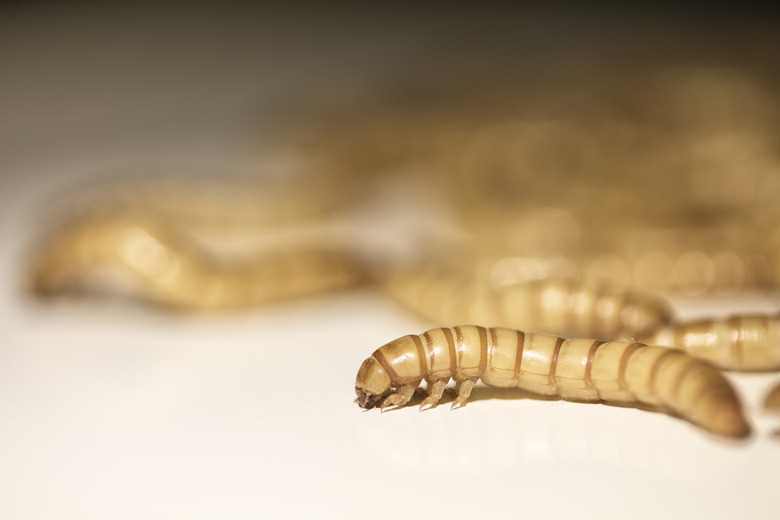What Is The Natural Habitat For Mealworms?
Mealworms (Tenebrio molitor) originally come from Africa but have become naturalized in other parts of the world, including North America. Wild mealworms are household pests as they often get into pantry food. However, throughout the world, live mealworms are well known for their use as food for birds and reptiles in captivity or as supplementary food for wild animals.
What Are Mealworms?
What Are Mealworms?
Mealworms are the larval form of darkling beetles. Like all beetles, they undergo complete metamorphosis, which means the larval form has a completely different body structure to the adult. After mating, the female darkling beetle lays between 70 and 100 eggs in a dark, moist location full of food, like among leaf litter. The eggs then hatch into creamy-white mealworm larvae.
Mealworm larva size ranges between one-half and one inch long depending on its age. Mealworms molt – a process where they shed their outer exoskeleton and grow a new one – between ten and 14 times before becoming pupae. Depending on the incubation temperature, a mealworm's pupa stage can take anywhere from six to 300 days.
Once emerged from the pupa, the new creamy white-colored beetle is approximately one-half inch long. It takes two to seven days for the beetle to become a dark brown color. The adult beetle has a lifespan of two to four weeks, sometimes longer in captivity.
Mealworms' Wild Habitat
Mealworms' Wild Habitat
When not infiltrating kitchen cupboards or stores of grains on farms, wild mealworms live in dark places in the leaf litter, under rocks or logs or in animal burrows. Both the mealworm larva and beetles eat what they are surrounded with. In the wild, their diet includes decaying leaf litter, sticks and grass. They are classified as generalized decomposers, so they may also eat new plant growth, grains, feces, dead insects or larger animals.
In the food web, decomposers are vital for breaking down materials and turning them into usable nutrients. Decomposers, like mealworms, help to fertilize plants. Mealworms also provide a nutritious food source to wild birds, reptiles, spiders and rodents.
Breeding Mealworms
Breeding Mealworms
Mealworms are prolific breeders, one aspect that makes them suitable for captive breeding. The ideal average temperature for keeping and cultivating mealworms is 77 degrees Fahrenheit. One way to halt breeding temporarily is to place a container of adult beetles in a refrigerator for a short time. After removing from the refrigerator the beetles will reanimate.
Observing the mating behavior of the males chasing females is one of the key ways to determine the beetles' sex. The other way to tell male from female mealworms is by looking at the plated segments, called sternites, on the underside of a beetle's body.
Females have no spaces between the three posterior sternites. These same lower sternites on males have obvious, pale-colored membranes between them. Additionally, on females, the fifth sternite is pointed, while on males, it's rounded.
How to Store Mealworms
How to Store Mealworms
Mealworms should be stored in a cool, dark place. If they are in a container, keep the lid partially off or have small holes drilled in the top to provide a fresh oxygen supply.
Mealworms can be fed a variety of foods, including oats, bran or dried cereal. Maintain a layer of food on the bottom of the container approximately two inches deep as the mealworms hide in it. A piece of banana, carrot, potato, orange or apple needs to be placed with the mealworms and replaced every few days to help keep them moist.
As mealworms are classified as a pest, any excess supply should not be released into the wild. Only feed live mealworms to birds. Feeding deceased or discolored mealworms to animals may cause Salmonella poisoning.
Cite This Article
MLA
Jerrett, Adrianne. "What Is The Natural Habitat For Mealworms?" sciencing.com, https://www.sciencing.com/natural-habitat-mealworms-5875648/. 30 September 2021.
APA
Jerrett, Adrianne. (2021, September 30). What Is The Natural Habitat For Mealworms?. sciencing.com. Retrieved from https://www.sciencing.com/natural-habitat-mealworms-5875648/
Chicago
Jerrett, Adrianne. What Is The Natural Habitat For Mealworms? last modified March 24, 2022. https://www.sciencing.com/natural-habitat-mealworms-5875648/
